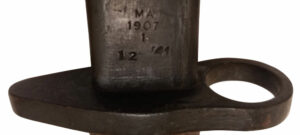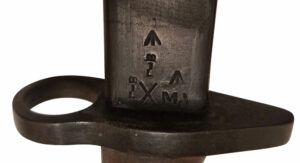Pattern 1907 British Bayonet

Pattern 1907 bayonet, officially called the Sword bayonet, pattern 1907 (Mark I), was a British bayonet designed to be used with the Short Magazine Lee Enfield(SMLE) rifle. It was used by the British and Commonwealth forces throughout both the First and Second World Wars. The markings on this interesting piece indicate that this was made for the Australian army during the WW II period.
Dimensions: Overall Length – 22 3/4″ Blade – 17″ L 1″ – W Grip: 4 3/4″ Weight: 1 lb. 11 oz.
 |
 |
 |
Bayonet Markings
When the British military adopted the Short Magazine Lee-Enfield rifle, its barrel was shortened to 25.2 inches (640 mm), 5 inches (130 mm) shorter than the preceding Magazine Lee-Enfield. British military strategists were fearful that the British infantry would be at a disadvantage when engaged in a bayonet duel with enemy soldiers who retained a longer reach.
In 1906–7 the British Army conducted trials to find a new longer standard issue bayonet. Experiments were conducted with a number of foreign bayonet designs, including a modified version of the American Model 1905 bayonet and the Japanese Type 30 bayonet. The trials resulted in the British Army adopting its own version of the Type 30 bayonet. The new design was designated Sword bayonet, pattern 1907 (Mark I) and was officially introduced on 30 January 1908. The Pattern 1907 bayonet consisted of a one-piece steel blade and tang, with a crossguard and pommel made from wrought iron or mild steel, and a wooden grip usually of walnut secured to the tang by two screws. The entire bayonet was 21 3⁄4 inches (550 mm) long and weighed 161⁄2ounces (470 g), although the weight of production models varied from 16 to 18 ounces.
 |
|
Official marks were stamped onto the Pattern 1907 bayonet’s ricass. On British manufactured bayonets the right side included an ‘X’ bend-test mark, a broad arrow government acceptance mark, and one or more Royal Small Arms Factory appointed inspector’s marks, on the left side was the date of the bayonet’s official inspection and the maker’s name and the reigning monarch’s crown and royal cypher, ‘ER’ (Edward Rex) or after 1910 ‘GR’ (George Rex).
The wooden grips of World War II era Australian bayonets were often marked ‘SLAZ’ for Slazenger, who made the grips during that war.

